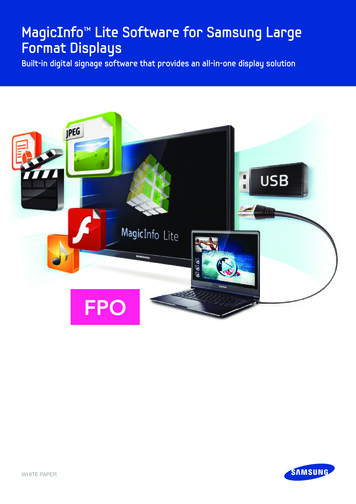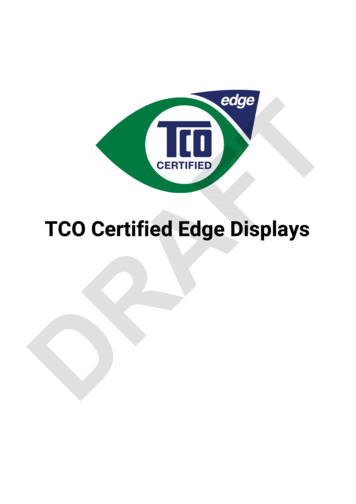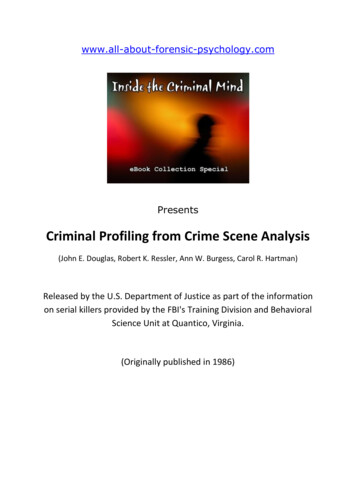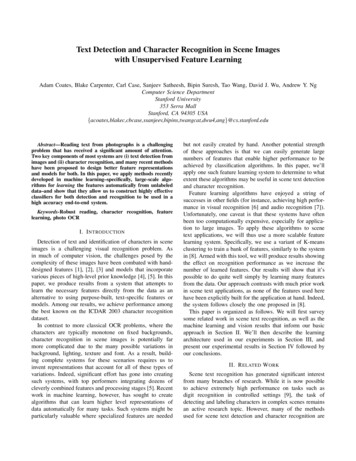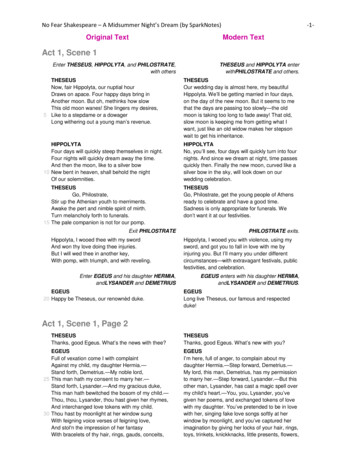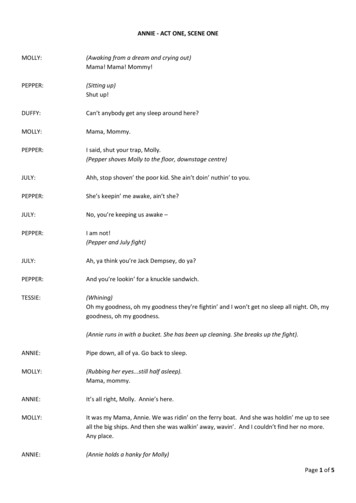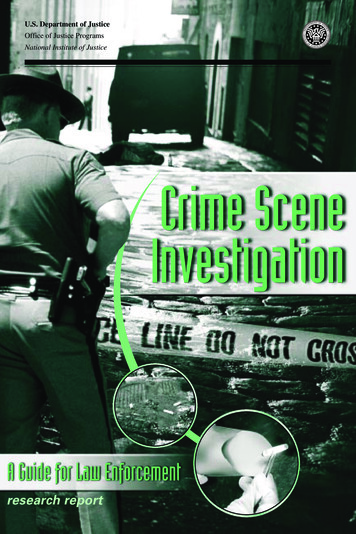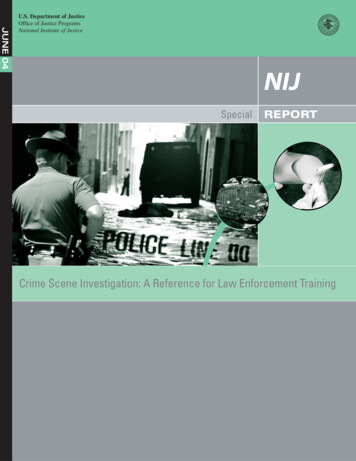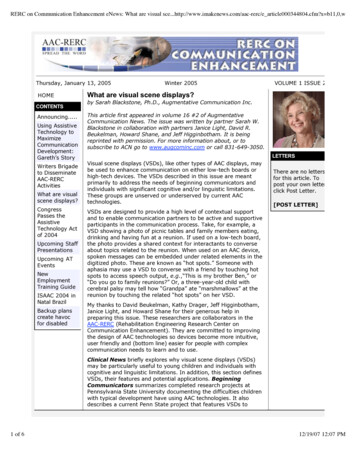
Transcription
RERC on Communication Enhancement eNews: What are visual sce.http://www.imakenews.com/aac-rerc/e article000344804.cfm?x b11,0,wThursday, January 13, 2005HOMECONTENTSAnnouncing.Using AssistiveTechnology toMaximizeCommunicationDevelopment:Gareth’s StoryWriters Brigadeto DisseminateAAC-RERCActivitiesWhat are visualscene displays?CongressPasses theAssistiveTechnology Actof 2004Upcoming StaffPresentationsUpcoming ATEventsNewEmploymentTraining GuideISAAC 2004 inNatal BrazilBackup planscreate havocfor disabledWinter 2005VOLUME 1 ISSUE 2What are visual scene displays?by Sarah Blackstone, Ph.D., Augmentative Communication Inc.This article first appeared in volume 16 #2 of AugmentativeCommunication News. The issue was written by partner Sarah W.Blackstone in collaboration with partners Janice Light, David R.Beukelman, Howard Shane, and Jeff Higginbotham. It is beingreprinted with permission. For more information about, or tosubscribe to ACN go to www.augcominc.com or call 831-649-3050.LETTERSVisual scene displays (VSDs), like other types of AAC displays, maybe used to enhance communication on either low-tech boards orhigh-tech devices. The VSDs described in this issue are meantprimarily to address the needs of beginning communicators andindividuals with significant cognitive and/or linguistic limitations.These groups are unserved or underserved by current AACtechnologies.There are no lettersfor this article. Topost your own letter,click Post Letter.[POST LETTER]VSDs are designed to provide a high level of contextual supportand to enable communication partners to be active and supportiveparticipants in the communication process. Take, for example, aVSD showing a photo of picnic tables and family members eating,drinking and having fun at a reunion. If used on a low-tech board,the photo provides a shared context for interactants to converseabout topics related to the reunion. When used on an AAC device,spoken messages can be embedded under related elements in thedigitized photo. These are known as “hot spots.” Someone withaphasia may use a VSD to converse with a friend by touching hotspots to access speech output, e.g.,“This is my brother Ben,” or“Do you go to family reunions?” Or, a three-year-old child withcerebral palsy may tell how “Grandpa” ate “marshmallows” at thereunion by touching the related “hot spots” on her VSD.My thanks to David Beukelman, Kathy Drager, Jeff Higginbotham,Janice Light, and Howard Shane for their generous help inpreparing this issue. These researchers are collaborators in theAAC-RERC (Rehabilitation Engineering Research Center onCommunication Enhancement). They are committed to improvingthe design of AAC technologies so devices become more intuitive,user friendly and (bottom line) easier for people with complexcommunication needs to learn and to use.Clinical News briefly explores why visual scene displays (VSDs)may be particularly useful to young children and individuals withcognitive and linguistic limitations. In addition, this section definesVSDs, their features and potential applications. BeginningCommunicators summarizes completed research projects atPennsylvania State University documenting the difficulties childrenwith typical development have using AAC technologies. It alsodescribes a current Penn State project that features VSDs to1 of 612/19/07 12:07 PM
RERC on Communication Enhancement eNews: What are visual sce.http://www.imakenews.com/aac-rerc/e article000344804.cfm?x b11,0,wsupport the language and communication development in youngchildren with severe communication impairments. Adults withAphasia summarizes work underway at the University of Nebraskaand describes ways in which VSDs support the social conversationsof individuals with severe aphasia. Other Applications of VSDs:Beyond Conversation discusses ways VSDs can support learning,offer prompts and provide information. It highlights a researchproject underway at Children’s Hospital Boston that is exploringways to use VSDs with children on the autism spectrum.Most of the technologies discussed in this issue are still prototypes.Even so, the ideas and approaches described herein can already becreatively put to use.Sarah W. Blackstone, Ph.D., CCC-SP, AuthorVisual scene displaysDecades ago, people who were unable to speak (or write) had torely solely on their impaired speech and other natural methods ofcommunication. This led to frustration for both the individuals andtheir communication partners. During the 1970s and 1980s, thedisability rights movement, new laws and new public policiesbrought children with severe physical, communication andcognitive disabilities into their neighborhood schools and gaveadults who had been sequestered at home or living in institutionsthe means to move out into their communities. Concurrently,teachers, therapists, family members and advocates found waysfor individuals with limited speech and language skills tocommunicate, by providing a growing range of AAC techniques andstrategies, such as manual signs, gestures, pictures and graphicsymbols. By the mid 1980s, the field of AAC had been firmlylaunched.Today we have machines that “talk” and a growing cadre ofprofessionals and advocates working to provide functionalcommunication to people with complex communication needs. TheAAC community has helped pave the roads to education,employment and community participation. AAC techniques,strategies and technologies have enabled some people with severecommunication impairments to fulfill the same social roles as theirnondisabled peers and to pursue their personal goals and dreams.However, many people who have complex communication needs arestill not benefiting from AAC technologies.Current AAC technologiesSimple AAC devices enable users to express a small number ofmessages. While useful, the messages are typically restricted to afew preprogrammed phrases. Other devices are more complex andhave dictionaries of symbols to represent language, an ability tostore and retrieve thousands of messages, colorful displays,intelligible voice output with male and female voices, multipleaccess options, environmental controls, Internet access and rateenhancing strategies.A common complaint about complex AAC devices, however, is theyare difficult to use and time consuming to learn. Research andclinical experience suggest that AAC technologies often placeenormous cognitive demands on the individuals who use them. For2 of 612/19/07 12:07 PM
RERC on Communication Enhancement eNews: What are visual sce.http://www.imakenews.com/aac-rerc/e article000344804.cfm?x b11,0,wexample, current AAC devices that are available to beginningcommunicators and individuals with cognitive and linguisticlimitations are comprised of isolated symbols, whose meaning mustbe learned. These symbols are typically arranged in rows andcolumns. Users must navigate through pages and pages ofsymbols to retrieve phrases or words to construct meaning, orthey must learn to use coding strategies (abbreviation expansion,semantic compaction, Morse code). The cognitive demands ofthese approaches make learning time-consuming. Some peoplemanage to master these systems, but many do not.Visual scene displaysAdvances in mainstream technologies (e.g., miniaturization,multi-functionality, storage capacities, processing speed, video,photo and voice capabilities, locator functions) offer options thatmay better address the requirements of people with complexcommunication needs who have, until now, been unserved orunderserved by AAC technologies. One approach researchers arecurrently investigating—visual scene displays (VSDs)—may beparticularly helpful to beginning communicators and individualswith cognitive and linguistic limitations. VSDs offer a way to (1)capture events in the individual’s life, (2) offer interactants agreater degree of contextual information to support interaction and(3) enable communication partners to participate more actively inthe communication process.Visual scene displays (VSDs) portray events, people, actions,objects and activities against the backgrounds within which theyoccur or exist. These scenes are used as an interface to languageand communication. A VSD may representa generic context (e.g., a drawing of a house with a yard,an office with workers or a school room with a teacher andstudents.)a personalized context (e.g., a digital photo of a childplaying in his bedroom or a picture of the family on abeach while on vacation.)Note: A VSD may also have animated elements (i.e., intelligentagents) that can move around a scene.Differences between VSDs and grid displaysFigure 1 illustrates and Table I contrasts some of the variables thatdifferentiate traditional AAC grid displays from visual scenedisplays: (a) primary types of representation used (e.g., photos,symbols, letters); (b) extent to which the representations arepersonalized (e.g., involve the individual in the scene, are familiar orgeneric); (c) how much context is provided in the representation(e.g., low isolated concepts; high concepts provided in a personalphoto); (d) type of layout (e.g., grid, full scene, partial scene,combination grid and scene); (e) how displays are managed (e.g.,menu pages, navigation bars); (f) how concepts are retrieved(e.g., by selecting a grid space, pop ups, hot spots, speech keys)and (g) primary uses of the display (e.g., communication ofwants/needs, information exchange, conversational support, socialinteraction, social closeness).3 of 612/19/07 12:07 PM
RERC on Communication Enhancement eNews: What are visual sce.http://www.imakenews.com/aac-rerc/e article000344804.cfm?x b11,0,wBoth VSDs and grid displays can be used on low- and high-techdevices. Traditional AAC displays are configured in grids, mostoften in rows and columns, with elements comprised of individualgraphic symbols, text and/or pictures arranged on the displayaccording to specific organizational strategies (i.e., by category, byactivity, alphabetically, or idiosyncratically). The elements on a griddisplay are decontextualized so that users can construct desiredmessages on numerous topics using the same symbols.In contrast, the elements of a VSD are components of apersonalized or generic scene, i.e., pictured events, persons,objects and related actions, organized in a coherent manner. Assuch, the display provides a specific communication environmentand a shared context within which individuals can tell stories,converse about a topic, engage in shared activities and so on. VSDsalso enable communication partners to assume a supportive role, ifneeded, to make interaction easier for beginning communicatorsand individuals with cognitive and linguistic limitations.4 of 612/19/07 12:07 PM
RERC on Communication Enhancement eNews: What are visual sce.http://www.imakenews.com/aac-rerc/e article000344804.cfm?x b11,0,wContributors to this issue (Beukelman, Light and Drager, Shane)currently are investigating various features of VSDs to determinewhich can best meet the needs of different population groups,including young children with complex communication needs,children with autism and adults with aphasia.Current applications of VSDs Depending upon the age andcognitive and linguistic needs of the individual using the display,VSDs can be configured to serve several purposes.Stimulate conversation between interactants. Adultswith aphasia and very young children often find it difficultto have conversations because of their limited languageskills. Yet, within a shared context and with a skilledcommunication partner, conversations can occur. Forexample, a man with severe aphasia, still has much toshare with his friends. Using a VSD with digitized photosof his trips and family activities, he can set topics,converse and navigate between topics when a friendcomes to visit.Support play, share experiences and tell stories. Billwants to play with his toy farm, so his Mom finds thepage on his AAC system that has a large photo of themplaying with the farm. Bill touches the part of the photothat has the bucket of feed that the farmer is carrying.Bill’s touch retrieves the speech output ‘feed.” His Momgets the farmer and waits. Bill then touches the cow inthe photo to retrieve the speech output “cow.” His Momtouches the farmer, the feed and the cow in sequenceand then says, “Oh, the farmer’s going to feed the cow,”and acts it out.Facilitate the active participation of interactantsduring shared activities. In this application, the activityis “in” the VSD. For example, Joe and his mom read thescanned pages from Brown Bear, Brown Bear, or sing “OldMacdonald had a farm” using a picture of a farm withvarious stanzas of the song.Provide instruction, specific information or prompts.Many children with autism are drawn to electronic screenmedia (e.g., videos, DVDs, TV) and, therefore, may findVSDs engaging. An animated character, known as anintelligent agent, may be useful in teaching languageconcepts or prompting the use of speech to label objects,activities and attributes.Potential benefits of VSDsVSDs are personalized, create a shared context, provide languagein context and enable partners to assume more responsibilityduring interactions. They also shift the focus away from theexpression of wants and needs toward social interaction and theexchange of ideas and information. VSDs can be highlypersonalized, which is important for young children learninglanguage and can be helpful for others as well (e.g., individuals withaphasia, autism, Down syndrome, etc.) VSDs may reduce cognitivedemands, make learning easier and offer beginning communicatorsand individuals with limited cognitive and linguistic skills immediatesuccess. Researchers report that very young children and5 of 612/19/07 12:07 PM
RERC on Communication Enhancement eNews: What are visual sce.http://www.imakenews.com/aac-rerc/e article000344804.cfm?x b11,0,windividuals with aphasia and autism have required minimal, if any,instruction before using devices configured with VSDs tocommunicate.Persons who rely on conventional AAC technology may also benefitfrom VSD support of their conversational interactions in much thesame ways that typical speakers use photo albums to support theircommunication. For example,Tom relies on AAC technology because his speech is largelyunintelligible as a result of amyotrophic lateral sclerosis. Whenhe takes a trip or goes to an event, his family takes digitalphotographs and develops a simple slide show. When meetingwith friends, the family runs the slide show in the backgroundon a portable computer. His guests often take a couple ofmoments to view the show before talking with Tom. If his AACtechnology contained VSD capability in addition to spelling,word prediction and message retrieval, he would probablyinteract more easily and effectively.AAC-RERC researchers are striving to inform the field about theways in which VSDs and hybrid (combination of grid and VSD)displays are effective with specific populations. They are observingthe impact of VSDs on early language/concept development and onsocial interaction. Neither the current nor the potential value ofongoing VSD research and development should beunderestimated. By continuing to explore the many unansweredquestions about VSDs, their configurations and their uses, thesepioneering researchers are opening new windows of communicationopportunities for individuals we don’t yet serve very well.[PRINTER FRIENDLY VERSION]Published by RERC on Communication EnhancementCopyright 2005 AAC-RERC. All rights reserved.TELL A FRIENDPowered by IMN 6 of 612/19/07 12:07 PM
Sarah W. Blackstone, Ph.D., CCC-SP, Author Visual scene displays Decades ago, people who were unable to speak (or write) had to rely solely on their impaired speech and other natural methods of communication. This led to frustration for both the individuals and thei


